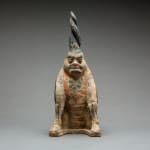Tang Sculpture of a Spirit Guardian, 618 CE - 908 CE
Terracotta
height 31.1 cm
height 12 1/4 in
height 12 1/4 in
LA.562
Further images
The inclusion of fantastic animal guardians as part of the retinue of tomb figures began in the Northern Wei dynasty (386-534) and continued into the Tang dynasty. Also called earth...
The inclusion of fantastic animal guardians as part of the retinue of tomb figures began in the Northern Wei dynasty (386-534) and continued into the Tang dynasty. Also called earth spirits ‘dusheng', or ‘zhenmushou’ ("grave-quelling beasts"), these guardians took the form of a fantastic hybrid creature composed of various animal and sometimes human elements and were placed in the tomb in pairs to ward off any malevolent beings who threatened to intrude. This apothropaic concept was indeed already present during the Warring States period (5th-4th centuries BC) in tombs from the southern state of Chu, where often ‘zhenmushou’ with incredible antler tines and long tongues sticking out were placed at the entrance of the tomb to guard the coffin and protect it from evil. However, in the south, tomb guardians quickly disappeared after the Eastern Jin period (317-420, an abrupt change of practice that probably reflected different cultural approaches. In fact, northern and western people -being more mindful of spirits and demons- were always more inclined to protect the dead from undesirable encounters and went into a lot of effort in creating wonderful sculptures of tomb guardians; southerners instead simply chose to continue to transmit the age-old practice of providing for the daily life of the deceased in the afterlife.
When looking at our human-faced earth spirit, it is clear that his face betrays distinctive Central Asian features; his twisted head gear is reminiscent of the tall pointed hats made of felt or soft material, worn by Central Asian merchants who frequently crowded the streets of the Tang capital, Chang’an. Some scholars in the past have also attempted to attribute these distinctive traits to either a group of Semitic merchants or to some ethnic groups from the Kashgar region of Central Asia, although neither possibility has been verified.
Yet this figure typifies the funerary guardian creatures of the seventh and early eight centuries. It is brilliantly painted with speckles on the shoulders and colourful painted flowers on the chest, both motifs possibly deriving from wax-resist techniques long popular in textile manufacture. It does not wear an armour, an accessory commonly found in human guardians instead, and his legs terminate in hooves, similarly to those found in the Astana tombs in the Turfan basin of Xinjiang and datable to the 7th- early 8th century AD. Although very little is known to date the Astana tombs precisely, it seems likely that these beats were introduced in the area after the Tang conquest of the kingdom of Gaochang in 640. Chinese control of the area lasted until the mid 8th century and many are the stylistic parallels in tomb furnishings between central China and Turfan, although the western regions seemed to have preferred painted decoration to the more popular sancai glaze of the metropolitan pieces.
Reference: J.C.Y. Watt et al, China. Dawn of a Golden Age, 200-750 AD, New York, 2004: no. 178-179, pp. 286-287.
When looking at our human-faced earth spirit, it is clear that his face betrays distinctive Central Asian features; his twisted head gear is reminiscent of the tall pointed hats made of felt or soft material, worn by Central Asian merchants who frequently crowded the streets of the Tang capital, Chang’an. Some scholars in the past have also attempted to attribute these distinctive traits to either a group of Semitic merchants or to some ethnic groups from the Kashgar region of Central Asia, although neither possibility has been verified.
Yet this figure typifies the funerary guardian creatures of the seventh and early eight centuries. It is brilliantly painted with speckles on the shoulders and colourful painted flowers on the chest, both motifs possibly deriving from wax-resist techniques long popular in textile manufacture. It does not wear an armour, an accessory commonly found in human guardians instead, and his legs terminate in hooves, similarly to those found in the Astana tombs in the Turfan basin of Xinjiang and datable to the 7th- early 8th century AD. Although very little is known to date the Astana tombs precisely, it seems likely that these beats were introduced in the area after the Tang conquest of the kingdom of Gaochang in 640. Chinese control of the area lasted until the mid 8th century and many are the stylistic parallels in tomb furnishings between central China and Turfan, although the western regions seemed to have preferred painted decoration to the more popular sancai glaze of the metropolitan pieces.
Reference: J.C.Y. Watt et al, China. Dawn of a Golden Age, 200-750 AD, New York, 2004: no. 178-179, pp. 286-287.





